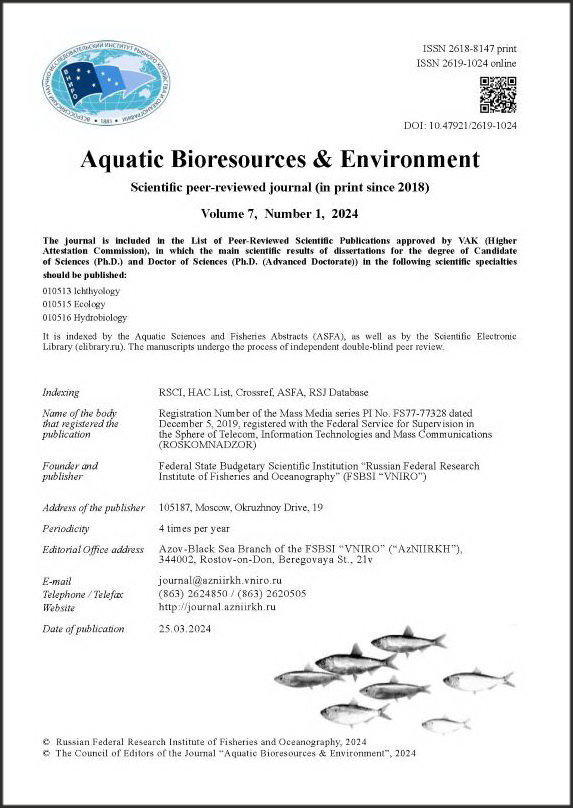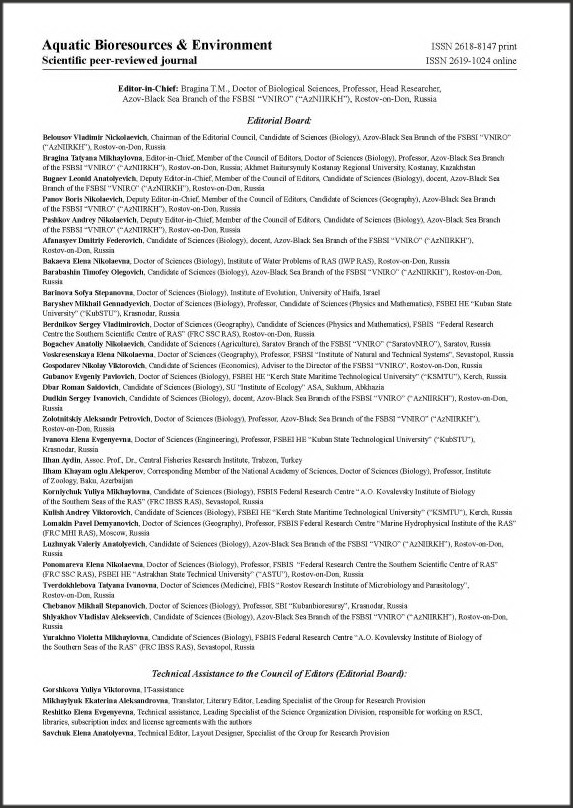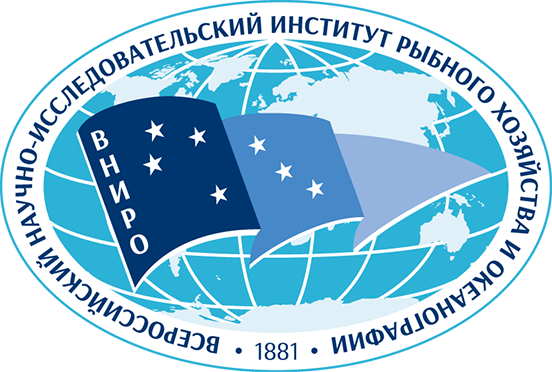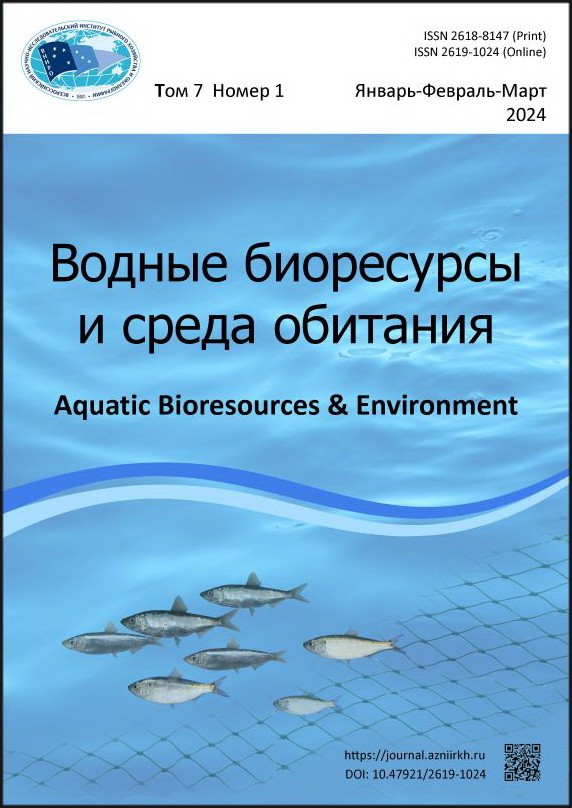

Volume 7 Number 1 2024
CONTENT
Environmental Concerns and the State of Aquatic Environment
Kochergin A.T.
Abstract
Background. Chlorophyll-α concentration is a key environmental parameter used to calculate the primary production of a water body, which, in turn, determines phytoplankton biomass. The fields with increased chlorophyll concentration can develop under the influence of various hydrometeorological factors considered in this work, such as air and water temperatures, cloud amount, wind-driven water mixing, and precipitation affecting the surface water layer. Relevance. Monitoring of chlorophyll distribution as it is influenced by hydrometeorological factors facilitates the rational fisheries management on account of their relation to the phytoplankton biomass providing fish and zooplankton with a food source. The aim of this work is to analyze the inter-annual variability of the average monthly hydrometeorological factors and their influence on the chlorophyll-α concentration in the Azov Sea (excluding Taganrog Bay) for the time range from 2006 to 2022. Methods. Spatial and temporal analysis of the average monthly water temperatures and chlorophyll-α concentrations has been conducted based on the daily satellite images of the sea surface taken by MODIS spectroradiometer in the Azov Sea; the analysis of the meteorological characteristics has been carried out using the weather observation data from international data exchange and reports (SYNOP, METAR) posted on the website pogodaiklimat.ru for the time range from April 2006 to September 2022. Results. It is shown that, for the entire investigated time range (2006–2022), the trends of the inter-annual variability of the average monthly air and water temperatures were not significant. An increase in water temperature that started in the middle of 1990s changed for the opposite in 2011, i. e. turned into a decrease. The wind velocity above the Azov Sea (excluding Taganrog Bay) over the investigated time range gradually decreased, which fell in line with the decrease in the chlorophyll-α concentrations. The average monthly cloud amount in the area has shown a weak inter- annual and considerable seasonal variability with relatively low values in the summer season and high values in the winter season. A positive trend of the monthly amount of atmospheric precipitation was observed, in contrast with the negative trend of the chlorophyll-α concentration. Conclusion. A significant positive correlation of the average monthly chlorophyll-α values with water and air temperatures has been identified, as well as a negative one with the wind velocity and cloud amount over the Azov Sea (excluding Taganrog Bay)—both in the individual investigated areas and in the sea as a whole.
Keywords: air temperature, sea surface temperature, wind velocity, cloud amount, precipitations,
chlorophyll-α, correlation
Biology and Ecology of Aquatic Organisms
The effect of certain pollutants on nectobenthic crustaceans
Trigub A.G., Medyankina M.V., Drozdenko T.V., Khayrulina T.P.
Abstract
Background. Ingress of pollutants in water bodies, both direct and from the catchment area, is constantly increasing. It creates an escalating threat to aquatic ecosystems and humans as consumers of water and aquatic biological resources, which contributes to the relevance of the monitoring and regulation of water pollution. This work is aimed at the evaluation of the effect of various toxic substances and pollutants on the survival of the amphipod Hyalella azteca in a chronic experiment. Methods. This study has been carried out according to the standard toxicological methods. Results. This paper presents the data on the influence of pollutants of various nature (sodium hydrogen phosphate, sodium sulfate, zinc complex of 2-Phosphono-1,2,4-butanetricarboxylic acid, dimethyl sulfide) on the Hyalella azteca Saussure, 1858 crustaceans. Hyalella azteca have found a wide application in biotesting; however, these crustaceans are not used in the system of fisheries regulation in Russia. The maximum allowable and threshold concentrations of the investigated substances in the aquatic environment have been established for Hyalella azteca using the experimental approach. The maximum allowable concentration (MAC) of sodium hydrogen phosphate in the phosphorus equivalent was 1.0 mg/L, its threshold concentration was 2.5 mg/L; the MAC of sodium sulfate in the sulfate anion equivalent was 750 mg/L, its threshold concentration was more than 750 mg/L; the MAC of the zinc complex of 2-Phosphono-1, 2,4-butanetricarboxylic acid was 10 mg/L, its threshold concentration was 100 mg/L; the MAC of dimethyl sulfide was 10 mg/L, its threshold concentration was 20 mg/L. Conclusion. The amphipods
H. azteca are moderately sensitive to pollutants. Among all investigated substances, the most toxic for H. azteca was sodium hydrogen phosphate.
Keywords: pollutants, aquatic environment, maximum allowable concentration, threshold concentration, crustaceans
Chernaya L.V., Kovalchuk L.A., Kozhaeva D.K., Zhantegolov D.V., Mikshevich N.V.
Abstract
Background. Medicinal leeches are a traditional aquatic biological resource in Russia, officially used in practical medicine, pharmacology and cosmetology. However, in recent decades, the distribution range and abundance of these valuable aquatic organisms on the Russian territiry have decreased considerably. Relevance. The study of the present geographical range of this exploitable leech species is of practical importance, since the modern technology of their controlled breeding at biological production facilities requires constant replenishment of the broodstock and procurement of mature individuals from natural populations. This work is aimed at the identification of the current habitats of medicinal leeches in the aquatic ecosystems of the Kabardino-Balkarian Republic. Methods. This research was carried out in the last ten days of August 2021 in the daytime, in the littoral part of the water bodies of the plain and foothill zones of Kabardino-Balkaria. Leeches were caught with a handheld net, as well as collected manually from the objects in the immediate surroundings. The species of the caught leeches were determined using taxonomic keys in accordance with the modern classification. Results. New data on the distribution of the exploitable species of medicinal leeches Hirudo verbana (Carena, 1820) in the aquatic ecosystems of Kabardino-Balkaria are presented. Habitats of natural populations of this leech species were found in the Trek Lake and Deya River. Conclusion. The presence of the medicinal leech H. verbana in the investigated water bodies indicates their good ecological state. The results of this study make it possible to expand our understanding of the present distribution range of this exploitable species of aquatic organisms. Keywords: distribution range, aquatic ecosystems of Kabardino-Balkaria, medicinal leeches, exploitable species
Ichthyofauna of Marine and Inland Water Bodies
Lepilina I.N., Konopleva I.V., Safaraliev I.A., Voynova T.V., Rakov A.M.
Abstract
Background. Anadromous species of sturgeons, salmonids and clupeids inhabiting the Caspian Sea migrate to their spawning grounds predominantly through the Volga-Caspian Sea Shipping Canal (VCSSC), which hydrological and hydrographic features have an effect on the abundance dynamics of the anadromous fish species. Along the entire delta sea edge, the Volga-Caspian Sea Shipping Canal (around 200 km in length) provides the conditions required for fish migration. Relevance. The current decrease in the Caspian Sea level and extensive accumulation of the fluvial and marine drift sediments impede navigation due to insufficient depth of the waterway and affect the entering of the anadromous breeders. This work is aimed at the assessment of the VCSSC use by sheefish, black-spined herring, beluga sturgeon, Russian sturgeon and stellate sturgeon during various seasons within 2001–2022 time range. Methods. Trawling and net fishing have been conducted in the marine part of the canal. Based on the data from seine catches in the river, the seasonal dynamics of fish migrations has been identified. Results. Despite the existence of extensive riverine network of the River Volga Delta suitable for the entering of anadromous fish species (Kirovsky, Belinsky, Igolkinsky, Karaysky and other banks), the Volga-Caspian Sea Shipping Canal (Main Bank) provides the anadromous fish species with a primary transit waterway to their spawning grounds—up to 90 % sheefish and black-backed herring breeders out of the total spawning stock abundance. The share of stellate sturgeon migrating along this waterway is 76–78 %, for the Russian sturgeon it is 83–85 %, and for beluga sturgeon it is 90–95 % of the spawning populations in the year of their entering into the Volga River. In recent years, the ecosystem of the Volga River has been developing in the context of low water content, which leads to the decrease in the water level of fish passage channels and tj a weakened flow, which, exacerbated by abiotic factors, in turn results in the reduction in the spawning stock abundance and decline in the yield of juveniles of the anadromous fish species [1]. Conclusion. During their pre-spawning season, sturgeons, sheefish and anadromous herring use the Volga-Caspian Sea Shipping Canal as the main migratory passageway to their spawning grounds. After the spawning, the canal provides juveniles and mature breeders with the passageways to the feeding sites in the Northern Caspian Sea. Sturgeon juveniles and the individuals skipping the spawning actively feed in the marine part of the canal [2].
Keywords: Caspian Sea, anadromous species, spawning population, migrations, abundance, biomass
Nadolinskiy R.V., Nadolinskiy V.P., Dudkin S.I.
Abstract
Background. Natural and anthropogenic factors have a major influence on the fish population status. In the Azov Sea, for the last 30 years, substantial changes in the environment have been observed and new exotic species of aquatic living organisms have been introduced, which affected reproduction of fish species. Relevance. To identify the driving forces behind the present dynamics of population abundance of European anchovy and Black and Caspian Sea sprat (tyulka), it is crucial to summarize the data collected during the annual ichthyoplankton surveys of the Azov Sea. This work is aimed at the assessment of the distribution of the ichthyoplankton and early juveniles of Black and Caspian Sea sprat (tyulka) and European anchovy in the Azov Sea area over time with regard to various environmental factors. Methods. Ichthyoplankton surveys are customarily conducted over the entirety of the Azov Sea in the middle of June, when eggs and larvae of Black and Caspian Sea sprat (tyulka) and European anchovy are caught at the highest quantities. Results. The dynamics of distribution and abundance variations for the early developmental stages of Black and Caspian Sea sprat (tyulka) and European anchovy under the influence of environmental factors, including ctenophores and scyphozoan jellyfishes, has been identified; a decrease in the survival rates of their jellyfishes juveniles in the present period of the Azov Sea salinization has been observed. Conclusion. In the context of increasing salinity of the Azov Sea waters, the main factors contributing to the reduced survival rates of the Black and Caspian Sea sprat (tyulka) larvae and fingerlings are the decrease in spawning ground area and competition for food resources with scyphozoan jellyfishes and ctenophores. In the case of the European anchovy larvae and fingerlings, the main factor affecting their abundance is a small number of breeders; food competition and predation of the scyphozoan jellyfishes and ctenophores are of secondary importance.
Keywords: eggs, larvae, ichthyoplankton, Black and Caspian Sea sprat, European anchovy, distribution, abundance, salinization, jellyfish, Mnemiopsis leidyi, Azov Sea
Aquaculture and Methods of Artificial Reproduction
Sedova D.A., Sazykina M.A., Zhuravlev P.V., Morozova M.A., Barabashin T.O., Sazykin I.S.
Abstract
Introduction. Aquaculture is one of the sectors of food production in which antibiotics are widely used. Taking into account the global problem of increasing drug resistance of microorganisms, aquaculture targets can serve as reservoirs for the accumulation, selection and distribution of antibiotic resistance genes (ARGs) and antibiotic resistant bacteria (ARB). Relevance. Currently, the ubiquity of antibiotic resistance genes is one of the threats to public health. Aim. This review discusses the results of studies of antibiotic resistance genes isolated both from various aquaculture environments (water, sediments, sewage) and from resistant bacteria that have etiological significance in the occurrence of diseases of commercial fish species, molluscs, crustaceans, etc. Methods. The analysis of both foreign and domestic publications has been carried out. In foreign studies, molecular genetic methods of detecting ARGs in total DNA samples of aquaculture targets are mainly used. The metagenomic quantification of the bacterial communities and ARGs by sequencing is the most indicative one. Results. Despite the relevance of the topic, there are no available publications that are directly devoted to the resistomes in the targets of the Russian aquaculture. Basically, the study of antibiotic resistance in this area focuses only on the phenotypic manifestations of the resistance of fish pathogenic bacteria to the antibiotics widely used in the Russian aquaculture. Conclusion. Accumulated research results on this subject matter are quite extensive; their summarization within a single review article might facilitate the further work in this area. Keywords: antibiotic resistance genes, antibiotic resistant bacteria, aquaculture, antibiotics, horizontal gene transfer
Fisheries and Processing of Aquatic Bioresources
Syromyatnikov I.A., Ivanova E.E., Chibich N.V.
Abstract
Introduction. Concentrated food products are in great demand for their lengthy storage time, high nutritional value and full readiness for consumption. The range of existing concentrated food products derived from fish is limited by the presence of intermuscular bones, high rates of fish oil oxidization, and by pronounced specific taste and flavor, usually undesirable by the consumers. These reasons contribute to the relevance of the exploration of possible ways to improve marketability and consumer appeal of minced fish and the development of recipes for the mixed fish- and plant-based concentrated food products derived from it. This work is aimed at the development of formulations for the mixed fish- and plant-based concentrated food products (snacks) derived from preprocessed fish mince with improved organoleptic and rheological properties. Over the course of this research, established and currently accepted research methods have been used. Results. It has been found out that rinsing fish mince with
1 % aqueous solution (aqueous system) based on mustard powder allows for the improvement of its texture, color, flavor and taste. With the use of mathematical modeling, optimal proportions (by weight) for the main components of the mixed fish- and plant-based concentrated food products have been identified: fish mince (70–85 %), wheat bran (9–10 %), carrot powder (5 %), and beet powder (10 %). Conclusion. It has been established that 1 % aqueous solution (aqueous system) of mustard powder can be used as a rinsing solution for fish mince to ensure its fresh flavor with pleasant mustard undertones, as well as vastly improved color and texture. The optimized weight percentages of the main components (fish mince, wheat bran, powdered carrot and beet) made it possible to obtain concentrated food products with attractive organoleptic properties.
Keywords: mixed fish- and plant-based concentrated food products, snacks, recipe, rinsing, fish mince, organoleptic properties
Informational Messages



